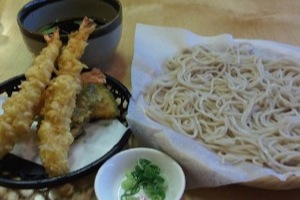By Linda Burum | Special to the Los Angeles Times
 Otafuku’s buckwheat noodle dishes show its owner’s affinity for artful cooking.
Otafuku’s buckwheat noodle dishes show its owner’s affinity for artful cooking.
In the year or so since Otafuku opened, word of owner Seiji Akutsu’s stunning handmade sarashina soba has spread through the Japanese foodie grapevine. Akutsu may be exactly the right guy to introduce us to the subtleties of artisanal buckwheat noodles. He was raised in a family business that organized formal events, occasionally for Japanese royalty, and his upbringing was steeped in michi, the Japanese reverence for precise adherence to tradition and protocol.
In a space no bigger than a walk-in closet, he daily transforms an unruly mound of buckwheat dough into the silky strands that are the caviar of Japanese noodles. He uses only bottled spring water and the finest imported gozen-ko (flour milled from the white buckwheat heart), kneading the dough in small batches and testing it by feel, since the balance of water to flour has to change with the humidity.
For customers who prefer the deep, earthy sweetness of darker soba, Akutsu uses ichiban-ko (second milling flour) blended with a tiny amount of wheat flour for cohesiveness (machine-made soba requires much more), allowing the robust buckwheat flavor to shine through. While soba is Akutsu’s true specialty, he also makes wheat flour noodles (udon).
With its clean lines and wood plank walls, Otafuku’s small dining room is stylish but still subtly implies the rustic associations of buckwheat. It’s odd to find such refined design–not to mention such exquisite food–in an obscure location such as this, down the street from two aging trailer parks and next door to a time-worn hangout called Micky’s Cocktails in Gardena.
Otafuku devotees, like the friend who introduced me to the shop, are the sort of people who’ll drive for hours to get the perfect lemon pie or barbecue. It hasn’t escaped them that while most noodle houses get by with just a hot and a cold broth, Otafuku offers six different broths to complement the various kinds of noodles and their serving temperatures.
So how are the noodles served? Instead of the usual lengthy list of noodle toppings, Akutsu has just a few traditional ones, just like high-end soba shops in Japan such as Honke Owari-ya in Kyoto or Masu- oto in Tokyo. Among them are shaggy-coated tempura shrimp and crackly tempura-style seafood clusters (akiage). Succulent grilled eel is another. As you might expect from a perfectionist, Akutsu gets his eel fresh, rather than buying the frozen barbecued product that many Japanese restaurants use.
Akutsu’s most accomplished dish isn’t on the menu. One day one of the calligraphic wall signs offered kiku-uchi, a noodle that’s rare even in Japan, where there are more than 40,000 soba shops. For soba aficionados, finding this notoriously hard-to-make noodle with its heady taste of undiluted buckwheat is at least as good as a jackpot on your first day in Vegas.
Purists often order their soba without garnish, the better to savor their chewy resiliency and ethereal flavor, and the first three items on this menu are plain noodles. Each is named for its serving basket, rather than the noodle; just remember that the seiro holds white sarashina soba, the zaru holds brown soba. They come with nothing but a light, slightly smoky dipping sauce and the usual wasabi and slivered onion for mixing into it. By the time you’re slurping up your last noodle, Mrs. Akutsu or one of the waiters will be at your elbow offering a steamy cup of yu (noodle cooking water). You mix it into the remaining concentrated sauce for a soul-warming soup.
One of my favorite items, torijiru, is chunks of free-range chicken in a light broth that sparkles with the essence of yuzu, the Japanese lime-like citrus, and may be had with any noodle. The traditional soba-shop appetizer tamagoyaki, a pillow-soft rolled omelet, makes the perfect complement. And of course, all the noodles may be had in steamy bowls of Otafuku’s rich-tasting broths.
L.A.’s soba scene has improved since the days when the few tiny noodle shops had to use dried soba. Today robot-like soba machines churn out fresh soba in a number of L.A. restaurants, but it can’t quite duplicate Akutsu’s artful touch.
16525 S. Western Ave., Gardena, (310) 532-9348
